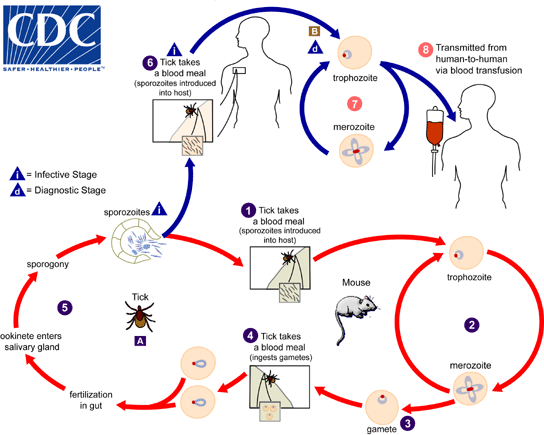Babesiosis pathophysiology: Difference between revisions
No edit summary |
|||
| Line 32: | Line 32: | ||
====Sporozoite development==== | ====Sporozoite development==== | ||
''Three notable stages of sporozoite development occur within the tick's salivary glands.'' | *''Three notable stages of sporozoite development occur within the tick's salivary glands.'' | ||
#Formation of a multinucleate sporoblast within a hypertrophied host cell. (Results in three dimensional branching and an eventual foundation for sporozoite budding.) | #Formation of a multinucleate sporoblast within a hypertrophied host cell. (Results in three dimensional branching and an eventual foundation for sporozoite budding.) | ||
# Host begins feeding, resulting in the formation of sporozoite's specialized organelles. | # Host begins feeding, resulting in the formation of sporozoite's specialized organelles. | ||
Revision as of 17:02, 14 January 2016
|
Babesiosis Microchapters |
|
Diagnosis |
|---|
|
Treatment |
|
Case Studies |
|
Babesiosis pathophysiology On the Web |
|
American Roentgen Ray Society Images of Babesiosis pathophysiology |
|
Risk calculators and risk factors for Babesiosis pathophysiology |
Editor-In-Chief: C. Michael Gibson, M.S., M.D. [1]; Associate Editor(s)-in-Chief: Tamar Sifri [2] Associate Editor(s)-in-Chief: Ilan Dock, B.S.
Overview
Babesia parasites reproduce in red blood cells, where they can be seen as cross-shaped inclusions (4 merozoites asexually budding but attached together forming a structure looking like a "Maltese Cross") and cause hemolytic anemia, quite similar to malaria. Note that unlike the Plasmodium parasites that cause malaria, Babesia species lack an exo-erythrotic phase, so the liver is usually not affected.
Pathogenesis

[http://www.cdc.gov/dpdx/babesiosis/index.html Babesia Biology CDC
The Babesia microti life cycle involves two primary components, an infected vertebrate host (primarily the white-footed mouse "Peromyscus leucopus"), and a tick in the genus Ixodes. [1]
Tick-mouse transmission:
- During a blood meal, a Babesia-infected tick introduces sporozoites into the mouse host.
- Sporozoites enter erythrocytes and undergo asexual reproduction (budding).
- In the blood, some parasites differentiate into male and female gametes, although these cannot be distinguished by light microscopy.
- The definitive host is the tick.
Pathogenic events within the tick
Ingestion
- Babesia organisms are detectable within 10 hours of tick ingestion.
- Parasitic organisms may still be detectable within erythrocytes until this point, however gametocytes begin to develop new organelles within 46 to 60 hours of ingestion.
- A notable physiological event occurs as gametocytes develop an arrowhead-shaped organelle.
- Research suggests that these arrowhead like structures are involved in gamete fusion.
Zygote development
- Zygotes maintain gamete's arrowhead like structures.
- These structures are used by the Zygote to penetrate epithelial cells within the tick's gut. Occurring within 80h of ingestion.
- Parasitic Organisms travel from epithelial cells in the tick gut to the salivary acini by means of the hemolymph.
Sporozoite development
- Three notable stages of sporozoite development occur within the tick's salivary glands.
- Formation of a multinucleate sporoblast within a hypertrophied host cell. (Results in three dimensional branching and an eventual foundation for sporozoite budding.)
- Host begins feeding, resulting in the formation of sporozoite's specialized organelles.
- Budding of sporozoites. A single sporoblast may result in 5,000 to 10,000 sporozoites.
Transmission
- Transmission occurs during a blood meal.
- Parasitic organism are transmitted through in the tick's saliva.
- Tick transmission is an efficient transmission method since the tick's saliva contains anti-inflammatory and immunosuppressive properties.
- Enabling transmission to occur largely undetected.
Transovarial transmission (also known as vertical, or hereditary, transmission) has been documented for "large" Babesia spp. but not for the "small" babesiae, such as B. microti (A).
Pathogenic events within a vertebrate host
Transmission
- Transmission occurs during tick feeding and attachment.
- Several thousand sporozoites are transmitted in the dermis surrounding the tick's mouth.
- Inoculation requires
- Humans enter the cycle when bitten by infected ticks. During a blood meal, a Babesia-infected tick introduces sporozoites into the human host.
- Sporozoites enter erythrocytes (B) and undergo (budding).
- Multiplication of the blood-stage parasites is responsible for the clinical manifestations of the disease. Humans are usually dead-end hosts. However, human-to-human transmission is well recognized to occur via contaminated blood transfusions.
References
- ↑ CDC Babesiosis. Biology. http://www.cdc.gov/parasites/babesiosis/biology.html Accessed December 21, 2016